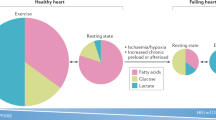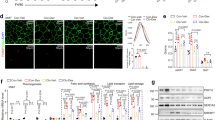Abstract
The peroxisome proliferator-activated receptor-γ (PPAR-γ) is a member of the nuclear receptor superfamily of ligand-dependent transcription factors that is predominantly expressed in adipose tissue, adrenal gland and spleen1,2,3. PPAR-γ has been demonstrated to regulate adipocyte differentiation and glucose homeostasis in response to several structurally distinct compounds, including thiazolidinediones and fibrates3,4,5,6. Naturally occurring compounds such as fatty acids and the prostaglandin D2 metabolite 15-deoxy-Δ12,14prostaglandin J2 (15d-PGJ2) bind to PPAR-γ and stimulate transcription of target genes7,8,9,10. Prostaglandin D2metabolites have not yet been identified in adipose tissue, butaremajor products of arachidonic-acid metabolism in macrophages11, raising the possibility that they might serve as endogenous PPAR-γ ligands in this cell type. Here we show that PPAR-γ is markedly upregulated in activated macrophages and inhibits the expression of the inducible nitric oxide synthase, gelatinase B and scavenger receptor A genes in response to 15d-PGJ2 and synthetic PPAR-γ ligands. PPAR-γ inhibits gene expression in part by antagonizing the activities of the transcription factors AP-1, STAT and NF-κB. These observations suggest that PPAR-γ and locally produced prostaglandin D2 metabolites are involved in the regulation of inflammatory responses, and raise the possibility that synthetic PPAR-γ ligands may be of therapeutic value in human diseases such as atherosclerosis and rheumatoid arthritis in which activated macrophages exert pathogenic effects.
This is a preview of subscription content, access via your institution
Access options
Subscribe to this journal
Receive 51 print issues and online access
$199.00 per year
only $3.90 per issue
Buy this article
- Purchase on Springer Link
- Instant access to full article PDF
Prices may be subject to local taxes which are calculated during checkout




Similar content being viewed by others
References
Kliewer, S. A. et al. Differential expression and activation of a family of murine peroxisome proliferator-activated receptors. Proc. Natl Acad. Sci. USA 91, 7355–7359 (1994).
Lemberger, T., Desvergne, B. & Wahli, W. PPARs: a nuclear receptor signaling pathway in lipid metabolism. Annu. Rev. Cell Dev. Biol. 12, 335–363 (1996).
Tontonoz, P., Hu, E., Graves, R. A., Budavari, A. I. & Spiegelman, B. M. mPPAR gamma 2: tissue-specific regulator of an adipocyte enhancer. Genes Dev. 8, 1224–1234 (1994).
Tontonoz, P., Hu, E. & Spiegelman, B. M. Stimulation of adipogenesis in fibroblasts by PPARγ2, a lipid-activated transcription factor. Cell 79, 1147–1156 (1994).
Lehmann, J. M. et al. An antidiabetic thiazolidinedione is a high affinity ligand for peroxisome prolifereator-activated receptor gamma (PPARgamma). J. Biol. Chem. 270, 12953–12956 (1995).
Willson, T. M. et al. The structure-activity relationship between peroxisome proliferator-activated receptor gamma agonism and the antihyperglycemic activity of thiazolidinediones. J. Med. Chem. 39, 665–668 (1996).
Kliewer, S. A. et al. Aprostaglandin J2metabolite binds peroxisome proliferator-activated receptorγ and promotes adipocyte differentiation. Cell 83, 813–819 (1995).
Forman, B. M. et al. 15-Deoxy-Δ12,14-prostaglandin J2is a ligand for the adipocyte determination factor PPARγ. Cell 83, 803–812 (1995).
Kliewer, S. A. et al. Fatty acids and eicosanoids regulate gene expression through direct interactions with peroxisome proliferator-activated receptors α and γ. Proc. Natl Acad. Sci. USA 94, 4318–4323 (1997).
Krey, G. et al. Fatty acids, eicosanoids, and hypolipidemic agents identified as ligands of peroxisome proliferator-activated receptors by coactivator-dependent receptor ligand assay. Mol. Endocrinol. 11, 779–791 (1997).
Urade, Y., Ujihara, M., Horiguchi, Y., Ikai, K. & Hayaishi, O. The major source of endogenous prostaglandin D2production is likely antigen-presenting cells. J. Immunol. 143, 2982–2989 (1989).
Lowenstein, C. J. et al. Macrophage nitric oxide synthase gene: two upstream regions mediate induction by interferon gamma and lipopolysaccharide. Proc. Natl Acad. Sci. USA 90, 8730–9734 (1993).
Hawke, R. L. et al. Potent hypocholesterolemic activity of novel ureido phenoxyisobutyrates correlates with their intrinsic fibrate potency and not with their ACAT inhibitory activity. J. Lipid Res. 38, 1189–1203 (1997).
Matrisian, L. M. The matrix degrading metalloproteinases. BioEssays 14, 455–463 (1992).
Welgus, H. G., Campbell, E.. J. & Cury, J. D. Neutral metalloproteinases produced by human mononuclear phagocytes. J. Clin. Invest. 86, 1496–1502 (1990).
Greene, M. E. et al. Isolation of the human peroxisome proliferator activated receptor gamma cDNA: expression in hematopoietic cells and chromosomal mapping. Gene Express. 4, 281–299 (1995).
Saarialho-Kere, U. K., Welgus, H. G. & Parks, W. C. Distinct mechanisms regulate interstitial collagenase and 92-kDa gelatinase expression in human monocytic-like cells exposed to bacterial endotoxin. J. Biol. Chem. 268, 17354–17361 (1993).
Sato, H. & Seiki, M. Regulatory mechanism of 92 kDa type IV collagenase gene expression which is associated with invasiveness of tumor cells. Oncogene 8, 395–405 (1993).
Krieger, M. & Herz, J. Structures and functions of multiligand lipoprotein receptors: macrophage scavenger receptors and LDL receptor-related protein (LRP). Annu. Rev. Biochem. 63, 601–637 (1994).
Wu, H., Moulton, K., Horvai, A., Parik, S. & Glass, C. K. Combinatorial interactions between AP-1 and ets-domain proteins contribute to the developmental regulation of the macrophage scavenger gene. Mol. Cell. Biol. 14, 2129–2139 (1994).
Xie, Q. W., Whisnant, R. & Nathan, C. Promoter of the mouse gene encoding calcium-independent nitric oxide synthase confers inducibility by interferon gamma and bacterial lipopolysaccharide. J. Exp. Med. 177, 1779–1784 (1993).
Lorsbach, R. B., Murphy, W. J., Lowenstein, C. J., Snyder, S. H. & Russell, S. W. Expression ofthe nitric oxide synthase gene in mouse macrophages activated for tumor cell killing. Molecular basis for the synergy between interferon-gamma and lipopolysaccharide. J. Biol. Chem. 268, 1908–1913 (1993).
Fanjul, A. et al. Anew class of retinoids with selective inhibition of AP-1 inhibits proliferation. Nature 372, 107–111 (1994).
Horvai, A. E. et al. Nuclear integration of JAK/STAT and Ras/AP-1 signaling by CBP and p300. Proc. Natl Acad. Sci. USA 94, 1074–1079 (1997).
Ausubel, F. et al. Current Protocols in Molecular Biology 1-0(John Wiley, New York, (1990)).
Green, L. C. et al. Analysis of nitrate, nitrite, and [15N]nitrate in biological fluids. Biochemistry 126, 131–138 (1982).
Zhu, Y., Pless, M., Inhorn, R., Mathey-Prevot, B. & D'Andrea, A. D. The murine DUB-1 gene is specifically induced by the βc subunit of the interleukin-3 receptor. Mol. Cell. Biol. 16, 4808–4817 (1996).
Acknowledgements
We thank C. Archer for assistance with nitrate measurements, and T. Schneiderman for assistance with manuscript preparation. A.C.L. is supported by a Physician Scientist grant from the NIH. C.J.K. is a clinical investigator of the Medical Research Service, Department of Veterans Affairs. C.K.G. is an established investigator of the American Heart Association. These studies were supported by NIH grants to C.J.K. and C.K.G.
Author information
Authors and Affiliations
Corresponding author
Supplementary Information
Rights and permissions
About this article
Cite this article
Ricote, M., Li, A., Willson, T. et al. The peroxisome proliferator-activated receptor-γ is a negative regulator of macrophage activation. Nature 391, 79–82 (1998). https://doi.org/10.1038/34178
Received:
Accepted:
Published:
Issue Date:
DOI: https://doi.org/10.1038/34178
This article is cited by
-
Einfluss von PPAR-γ-Agonisten auf die kalzifizierende Degeneration kardiovaskulärer Prothesen
Zeitschrift für Herz-,Thorax- und Gefäßchirurgie (2024)
-
PPARγ partial agonist LPSF/GQ-16 prevents dermal and pulmonary fibrosis in HOCl-induced systemic sclerosis (SSc) and modulates cytokine production in PBMC of SSc patients
Inflammopharmacology (2024)
-
Macrophages in immunoregulation and therapeutics
Signal Transduction and Targeted Therapy (2023)
-
FABP7 drives an inflammatory response in human astrocytes and is upregulated in Alzheimer’s disease
GeroScience (2023)
-
Peroxisome proliferator activated receptor-gamma (PPAR-γ) ligand, pioglitazone, increases analgesic and anti-inflammatory effects of naproxen
Naunyn-Schmiedeberg's Archives of Pharmacology (2023)
Comments
By submitting a comment you agree to abide by our Terms and Community Guidelines. If you find something abusive or that does not comply with our terms or guidelines please flag it as inappropriate.



